Aviation Industry: Regulations for Dangerous Goods Transport
VerifiedAdded on 2022/12/27
|11
|2681
|96
Report
AI Summary
This report delves into the critical aspect of dangerous goods regulations within the aviation industry, emphasizing the importance of operations management in ensuring passenger safety and efficient transport. It defines dangerous goods, categorizing them based on their hazardous properties, including explosives, gases, flammable liquids and solids, and oxidizing agents. The report outlines the roles of regulatory bodies like the International Civil Aviation Organization (ICAO) and the International Air Transport Association (IATA), detailing their guidelines and training programs for crew members to identify and manage risks associated with dangerous goods. A case study from April 2007 illustrates the consequences of non-compliance, highlighting the need for stringent screening and handling procedures. The report concludes by underscoring the significance of adhering to regulations to minimize risks and maintain safety standards within the aviation sector, focusing on the prohibition of flammable goods and the importance of specialized aircraft for permissible goods.
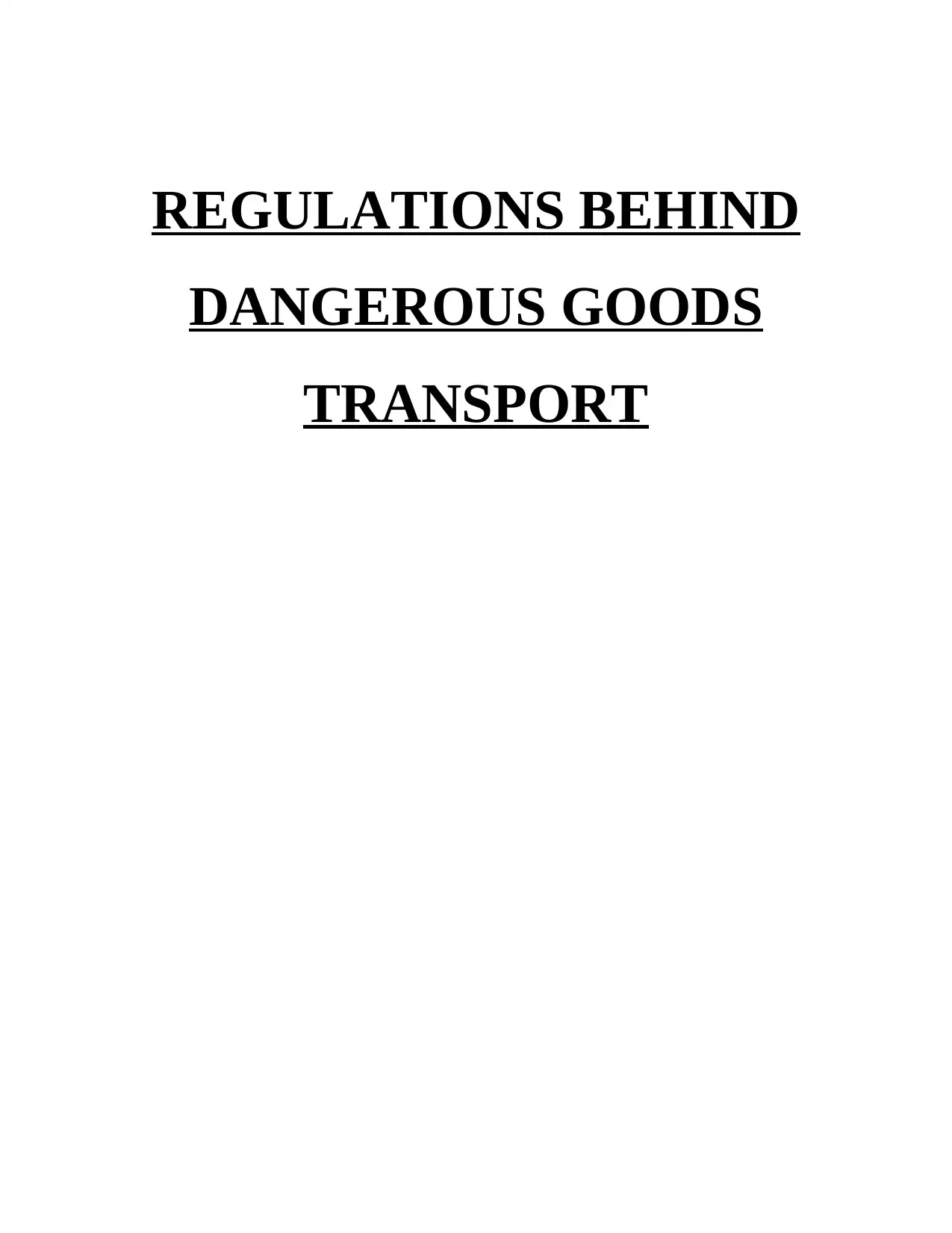
REGULATIONS BEHIND
DANGEROUS GOODS
TRANSPORT
DANGEROUS GOODS
TRANSPORT
Paraphrase This Document
Need a fresh take? Get an instant paraphrase of this document with our AI Paraphraser
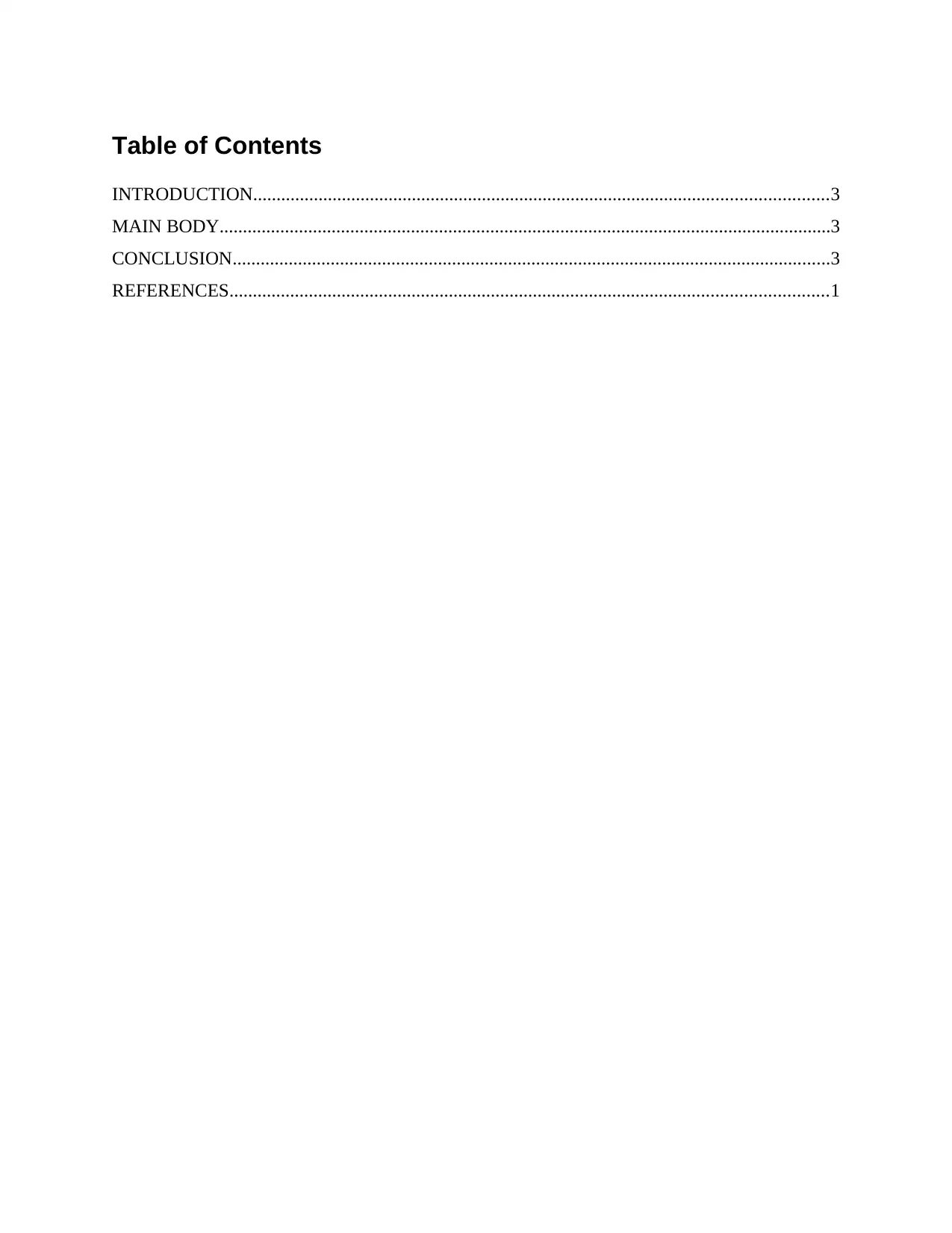
Table of Contents
INTRODUCTION...........................................................................................................................3
MAIN BODY...................................................................................................................................3
CONCLUSION................................................................................................................................3
REFERENCES................................................................................................................................1
INTRODUCTION...........................................................................................................................3
MAIN BODY...................................................................................................................................3
CONCLUSION................................................................................................................................3
REFERENCES................................................................................................................................1
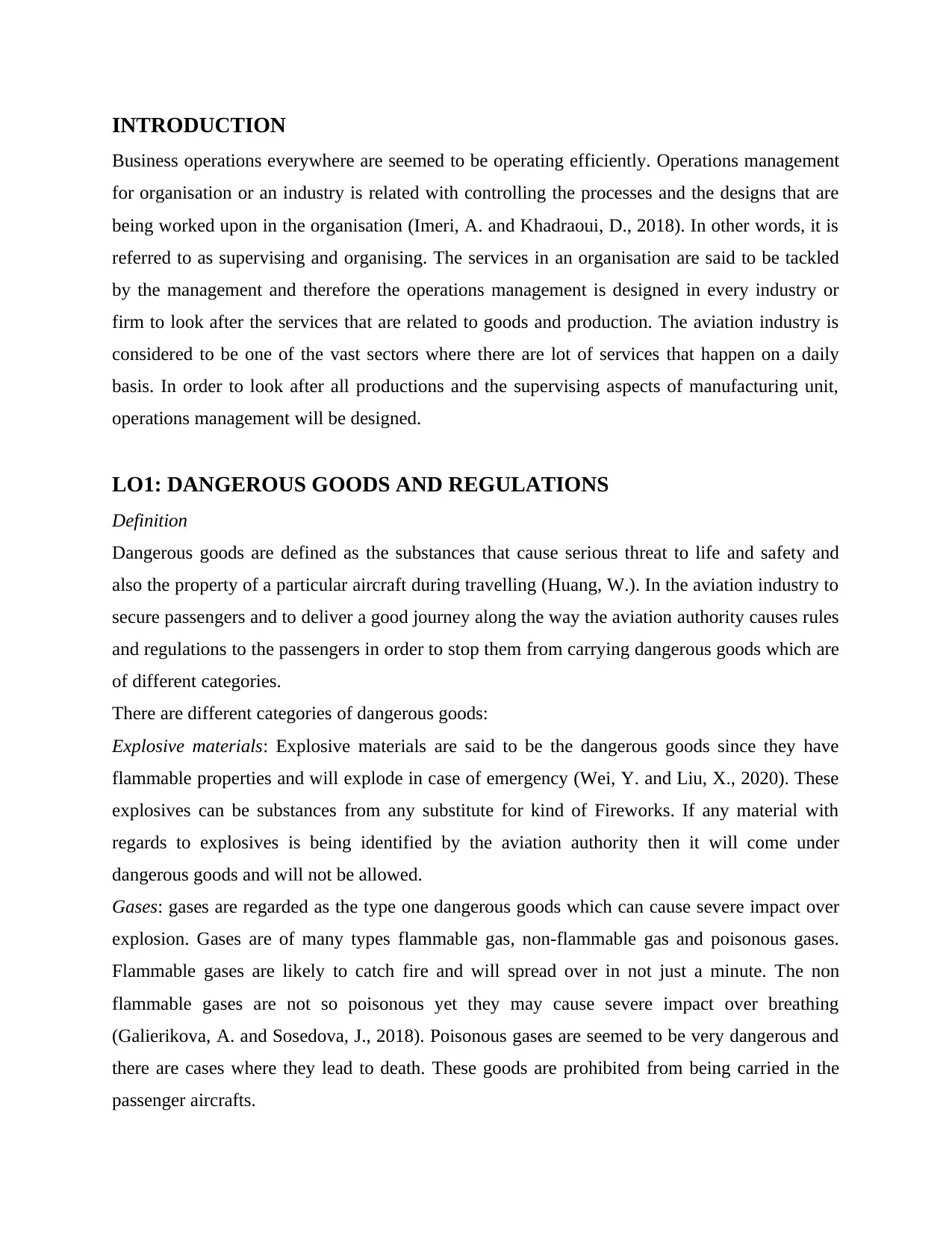
INTRODUCTION
Business operations everywhere are seemed to be operating efficiently. Operations management
for organisation or an industry is related with controlling the processes and the designs that are
being worked upon in the organisation (Imeri, A. and Khadraoui, D., 2018). In other words, it is
referred to as supervising and organising. The services in an organisation are said to be tackled
by the management and therefore the operations management is designed in every industry or
firm to look after the services that are related to goods and production. The aviation industry is
considered to be one of the vast sectors where there are lot of services that happen on a daily
basis. In order to look after all productions and the supervising aspects of manufacturing unit,
operations management will be designed.
LO1: DANGEROUS GOODS AND REGULATIONS
Definition
Dangerous goods are defined as the substances that cause serious threat to life and safety and
also the property of a particular aircraft during travelling (Huang, W.). In the aviation industry to
secure passengers and to deliver a good journey along the way the aviation authority causes rules
and regulations to the passengers in order to stop them from carrying dangerous goods which are
of different categories.
There are different categories of dangerous goods:
Explosive materials: Explosive materials are said to be the dangerous goods since they have
flammable properties and will explode in case of emergency (Wei, Y. and Liu, X., 2020). These
explosives can be substances from any substitute for kind of Fireworks. If any material with
regards to explosives is being identified by the aviation authority then it will come under
dangerous goods and will not be allowed.
Gases: gases are regarded as the type one dangerous goods which can cause severe impact over
explosion. Gases are of many types flammable gas, non-flammable gas and poisonous gases.
Flammable gases are likely to catch fire and will spread over in not just a minute. The non
flammable gases are not so poisonous yet they may cause severe impact over breathing
(Galierikova, A. and Sosedova, J., 2018). Poisonous gases are seemed to be very dangerous and
there are cases where they lead to death. These goods are prohibited from being carried in the
passenger aircrafts.
Business operations everywhere are seemed to be operating efficiently. Operations management
for organisation or an industry is related with controlling the processes and the designs that are
being worked upon in the organisation (Imeri, A. and Khadraoui, D., 2018). In other words, it is
referred to as supervising and organising. The services in an organisation are said to be tackled
by the management and therefore the operations management is designed in every industry or
firm to look after the services that are related to goods and production. The aviation industry is
considered to be one of the vast sectors where there are lot of services that happen on a daily
basis. In order to look after all productions and the supervising aspects of manufacturing unit,
operations management will be designed.
LO1: DANGEROUS GOODS AND REGULATIONS
Definition
Dangerous goods are defined as the substances that cause serious threat to life and safety and
also the property of a particular aircraft during travelling (Huang, W.). In the aviation industry to
secure passengers and to deliver a good journey along the way the aviation authority causes rules
and regulations to the passengers in order to stop them from carrying dangerous goods which are
of different categories.
There are different categories of dangerous goods:
Explosive materials: Explosive materials are said to be the dangerous goods since they have
flammable properties and will explode in case of emergency (Wei, Y. and Liu, X., 2020). These
explosives can be substances from any substitute for kind of Fireworks. If any material with
regards to explosives is being identified by the aviation authority then it will come under
dangerous goods and will not be allowed.
Gases: gases are regarded as the type one dangerous goods which can cause severe impact over
explosion. Gases are of many types flammable gas, non-flammable gas and poisonous gases.
Flammable gases are likely to catch fire and will spread over in not just a minute. The non
flammable gases are not so poisonous yet they may cause severe impact over breathing
(Galierikova, A. and Sosedova, J., 2018). Poisonous gases are seemed to be very dangerous and
there are cases where they lead to death. These goods are prohibited from being carried in the
passenger aircrafts.
⊘ This is a preview!⊘
Do you want full access?
Subscribe today to unlock all pages.

Trusted by 1+ million students worldwide
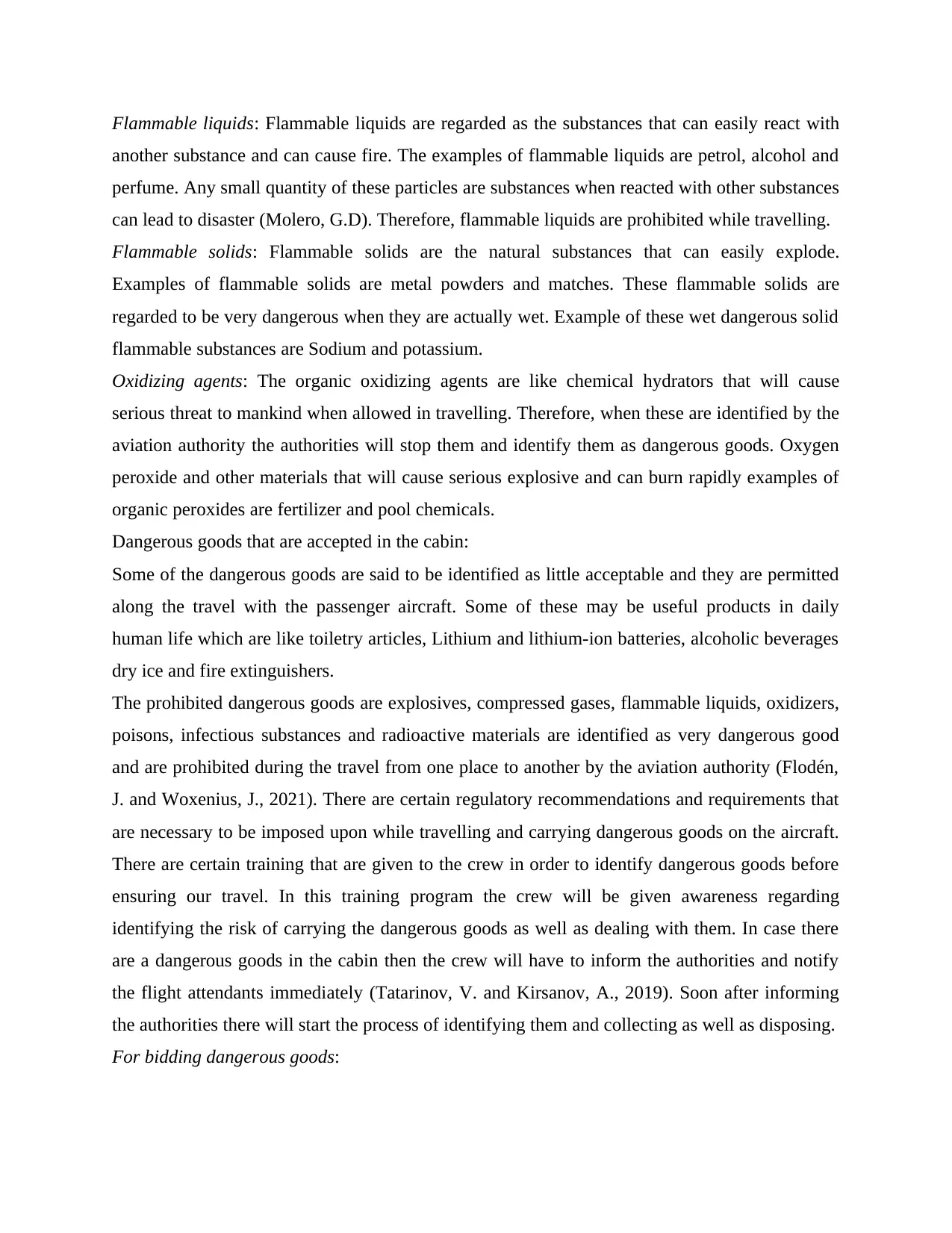
Flammable liquids: Flammable liquids are regarded as the substances that can easily react with
another substance and can cause fire. The examples of flammable liquids are petrol, alcohol and
perfume. Any small quantity of these particles are substances when reacted with other substances
can lead to disaster (Molero, G.D). Therefore, flammable liquids are prohibited while travelling.
Flammable solids: Flammable solids are the natural substances that can easily explode.
Examples of flammable solids are metal powders and matches. These flammable solids are
regarded to be very dangerous when they are actually wet. Example of these wet dangerous solid
flammable substances are Sodium and potassium.
Oxidizing agents: The organic oxidizing agents are like chemical hydrators that will cause
serious threat to mankind when allowed in travelling. Therefore, when these are identified by the
aviation authority the authorities will stop them and identify them as dangerous goods. Oxygen
peroxide and other materials that will cause serious explosive and can burn rapidly examples of
organic peroxides are fertilizer and pool chemicals.
Dangerous goods that are accepted in the cabin:
Some of the dangerous goods are said to be identified as little acceptable and they are permitted
along the travel with the passenger aircraft. Some of these may be useful products in daily
human life which are like toiletry articles, Lithium and lithium-ion batteries, alcoholic beverages
dry ice and fire extinguishers.
The prohibited dangerous goods are explosives, compressed gases, flammable liquids, oxidizers,
poisons, infectious substances and radioactive materials are identified as very dangerous good
and are prohibited during the travel from one place to another by the aviation authority (Flodén,
J. and Woxenius, J., 2021). There are certain regulatory recommendations and requirements that
are necessary to be imposed upon while travelling and carrying dangerous goods on the aircraft.
There are certain training that are given to the crew in order to identify dangerous goods before
ensuring our travel. In this training program the crew will be given awareness regarding
identifying the risk of carrying the dangerous goods as well as dealing with them. In case there
are a dangerous goods in the cabin then the crew will have to inform the authorities and notify
the flight attendants immediately (Tatarinov, V. and Kirsanov, A., 2019). Soon after informing
the authorities there will start the process of identifying them and collecting as well as disposing.
For bidding dangerous goods:
another substance and can cause fire. The examples of flammable liquids are petrol, alcohol and
perfume. Any small quantity of these particles are substances when reacted with other substances
can lead to disaster (Molero, G.D). Therefore, flammable liquids are prohibited while travelling.
Flammable solids: Flammable solids are the natural substances that can easily explode.
Examples of flammable solids are metal powders and matches. These flammable solids are
regarded to be very dangerous when they are actually wet. Example of these wet dangerous solid
flammable substances are Sodium and potassium.
Oxidizing agents: The organic oxidizing agents are like chemical hydrators that will cause
serious threat to mankind when allowed in travelling. Therefore, when these are identified by the
aviation authority the authorities will stop them and identify them as dangerous goods. Oxygen
peroxide and other materials that will cause serious explosive and can burn rapidly examples of
organic peroxides are fertilizer and pool chemicals.
Dangerous goods that are accepted in the cabin:
Some of the dangerous goods are said to be identified as little acceptable and they are permitted
along the travel with the passenger aircraft. Some of these may be useful products in daily
human life which are like toiletry articles, Lithium and lithium-ion batteries, alcoholic beverages
dry ice and fire extinguishers.
The prohibited dangerous goods are explosives, compressed gases, flammable liquids, oxidizers,
poisons, infectious substances and radioactive materials are identified as very dangerous good
and are prohibited during the travel from one place to another by the aviation authority (Flodén,
J. and Woxenius, J., 2021). There are certain regulatory recommendations and requirements that
are necessary to be imposed upon while travelling and carrying dangerous goods on the aircraft.
There are certain training that are given to the crew in order to identify dangerous goods before
ensuring our travel. In this training program the crew will be given awareness regarding
identifying the risk of carrying the dangerous goods as well as dealing with them. In case there
are a dangerous goods in the cabin then the crew will have to inform the authorities and notify
the flight attendants immediately (Tatarinov, V. and Kirsanov, A., 2019). Soon after informing
the authorities there will start the process of identifying them and collecting as well as disposing.
For bidding dangerous goods:
Paraphrase This Document
Need a fresh take? Get an instant paraphrase of this document with our AI Paraphraser
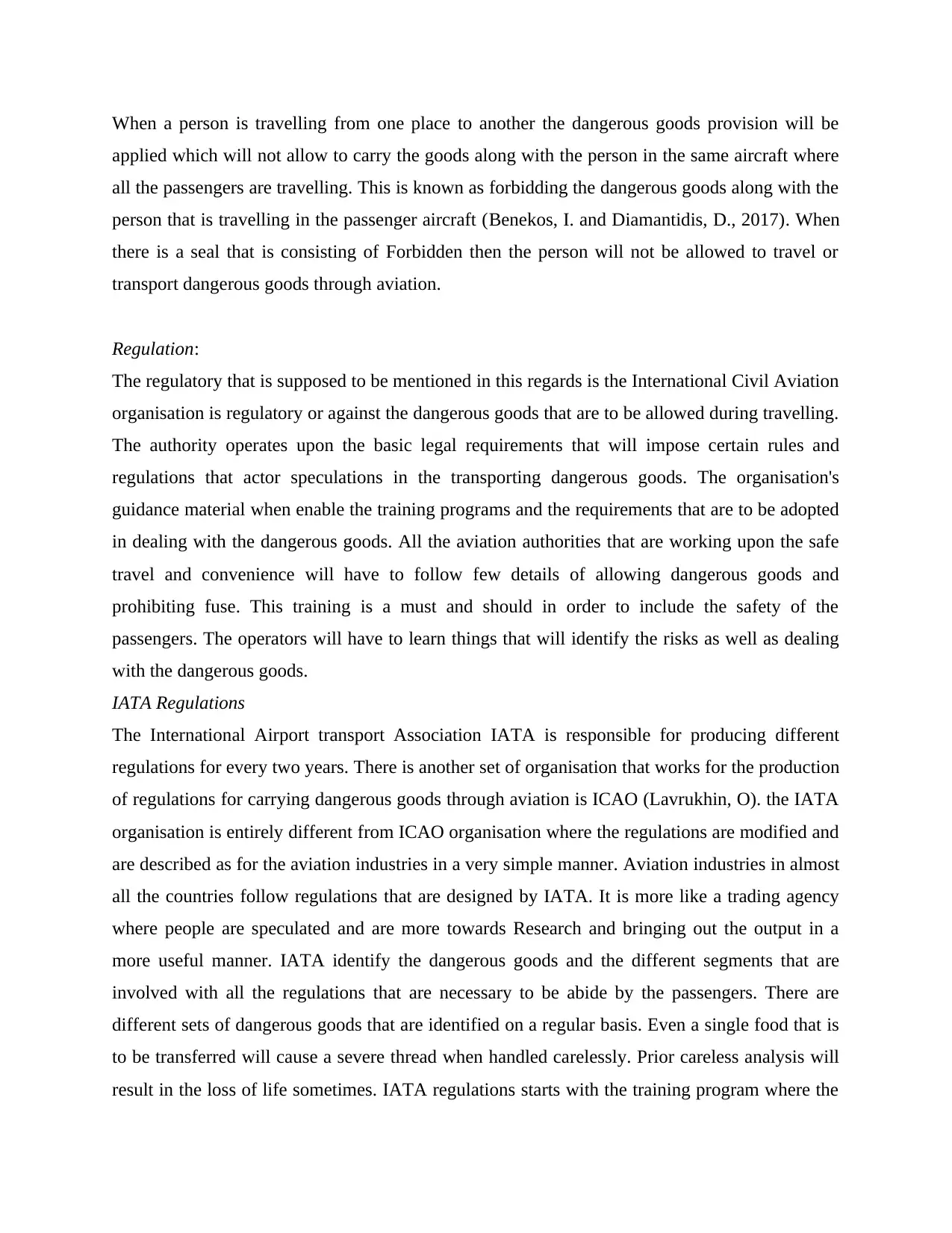
When a person is travelling from one place to another the dangerous goods provision will be
applied which will not allow to carry the goods along with the person in the same aircraft where
all the passengers are travelling. This is known as forbidding the dangerous goods along with the
person that is travelling in the passenger aircraft (Benekos, I. and Diamantidis, D., 2017). When
there is a seal that is consisting of Forbidden then the person will not be allowed to travel or
transport dangerous goods through aviation.
Regulation:
The regulatory that is supposed to be mentioned in this regards is the International Civil Aviation
organisation is regulatory or against the dangerous goods that are to be allowed during travelling.
The authority operates upon the basic legal requirements that will impose certain rules and
regulations that actor speculations in the transporting dangerous goods. The organisation's
guidance material when enable the training programs and the requirements that are to be adopted
in dealing with the dangerous goods. All the aviation authorities that are working upon the safe
travel and convenience will have to follow few details of allowing dangerous goods and
prohibiting fuse. This training is a must and should in order to include the safety of the
passengers. The operators will have to learn things that will identify the risks as well as dealing
with the dangerous goods.
IATA Regulations
The International Airport transport Association IATA is responsible for producing different
regulations for every two years. There is another set of organisation that works for the production
of regulations for carrying dangerous goods through aviation is ICAO (Lavrukhin, O). the IATA
organisation is entirely different from ICAO organisation where the regulations are modified and
are described as for the aviation industries in a very simple manner. Aviation industries in almost
all the countries follow regulations that are designed by IATA. It is more like a trading agency
where people are speculated and are more towards Research and bringing out the output in a
more useful manner. IATA identify the dangerous goods and the different segments that are
involved with all the regulations that are necessary to be abide by the passengers. There are
different sets of dangerous goods that are identified on a regular basis. Even a single food that is
to be transferred will cause a severe thread when handled carelessly. Prior careless analysis will
result in the loss of life sometimes. IATA regulations starts with the training program where the
applied which will not allow to carry the goods along with the person in the same aircraft where
all the passengers are travelling. This is known as forbidding the dangerous goods along with the
person that is travelling in the passenger aircraft (Benekos, I. and Diamantidis, D., 2017). When
there is a seal that is consisting of Forbidden then the person will not be allowed to travel or
transport dangerous goods through aviation.
Regulation:
The regulatory that is supposed to be mentioned in this regards is the International Civil Aviation
organisation is regulatory or against the dangerous goods that are to be allowed during travelling.
The authority operates upon the basic legal requirements that will impose certain rules and
regulations that actor speculations in the transporting dangerous goods. The organisation's
guidance material when enable the training programs and the requirements that are to be adopted
in dealing with the dangerous goods. All the aviation authorities that are working upon the safe
travel and convenience will have to follow few details of allowing dangerous goods and
prohibiting fuse. This training is a must and should in order to include the safety of the
passengers. The operators will have to learn things that will identify the risks as well as dealing
with the dangerous goods.
IATA Regulations
The International Airport transport Association IATA is responsible for producing different
regulations for every two years. There is another set of organisation that works for the production
of regulations for carrying dangerous goods through aviation is ICAO (Lavrukhin, O). the IATA
organisation is entirely different from ICAO organisation where the regulations are modified and
are described as for the aviation industries in a very simple manner. Aviation industries in almost
all the countries follow regulations that are designed by IATA. It is more like a trading agency
where people are speculated and are more towards Research and bringing out the output in a
more useful manner. IATA identify the dangerous goods and the different segments that are
involved with all the regulations that are necessary to be abide by the passengers. There are
different sets of dangerous goods that are identified on a regular basis. Even a single food that is
to be transferred will cause a severe thread when handled carelessly. Prior careless analysis will
result in the loss of life sometimes. IATA regulations starts with the training program where the

crew of the aviation industry are properly trained in analysing the risk factors that are associated
with carrying the dangerous goods. Based on the cabin in which the goods are being transferred
from one place to another the different set of rules vary. There are goods which are classified to
be less dangerous and more dangerous. The less dangerous goods are sent through different
cabins there as the more dangerous goods are prohibited at the beginning. the quantity of the
goods that are to be carried along with the passenger are decided based on the weight that is
allotted to each passenger cabin. when the cabin override the less dangerous board will also be
prohibited from entering into the cabin. there will be a Priority check at the beginning of the
boarding where the crew will identify the particulate matter that come under dangerous goods.
According to the various sections of regulations few things will not be allowed to enter into the
aircraft which can cause severe impact. Every aviation industry is designed in such a manner that
promotes safety of the passenger and their for identification of dangerous goods is regarded to be
one of the crucial criteria that is followed in almost all the organisations around the world. In
most unusual cases people tend to escape the boarding check then the goods will therefore be
found in the aircraft by the authority check.
LO2: CASE STUDY
The case study that is going to be mentioned in this regards is that which occurred in April 2007
and is identified by the dangerous goods monthly report. The dangerous goods in this regard are
the substances that will cause serious threat to the travelling purposes of the passenger.
Dangerous goods are those substances that will impact seriously and are said to be by the
aviation authority and usually they are not allowed to enter into the aircraft. The regulations that
are listed in the dangerous goods are said to be speculated where everything is being cross check
twice before allowing particular goods that are regarded as dangerous into the cabin. The
incident occurred in such a way where the passenger took fireworks which look like long Roman
candles that were 48 in Count. These were found to be less dangerous goods and therefore the
aviation authority have allowed them to travel along with the passenger. It was altogether a 32
packets of friction ignition that took place in the cabin and therefore it is identified as one of the
flammable substance and the aviation authority have imposed prohibition upon travelling with
the same. It was like altogether too hard for this particular passenger upon identifying this
firework and then the aviation authorities have stopped the particular passenger from carrying
with carrying the dangerous goods. Based on the cabin in which the goods are being transferred
from one place to another the different set of rules vary. There are goods which are classified to
be less dangerous and more dangerous. The less dangerous goods are sent through different
cabins there as the more dangerous goods are prohibited at the beginning. the quantity of the
goods that are to be carried along with the passenger are decided based on the weight that is
allotted to each passenger cabin. when the cabin override the less dangerous board will also be
prohibited from entering into the cabin. there will be a Priority check at the beginning of the
boarding where the crew will identify the particulate matter that come under dangerous goods.
According to the various sections of regulations few things will not be allowed to enter into the
aircraft which can cause severe impact. Every aviation industry is designed in such a manner that
promotes safety of the passenger and their for identification of dangerous goods is regarded to be
one of the crucial criteria that is followed in almost all the organisations around the world. In
most unusual cases people tend to escape the boarding check then the goods will therefore be
found in the aircraft by the authority check.
LO2: CASE STUDY
The case study that is going to be mentioned in this regards is that which occurred in April 2007
and is identified by the dangerous goods monthly report. The dangerous goods in this regard are
the substances that will cause serious threat to the travelling purposes of the passenger.
Dangerous goods are those substances that will impact seriously and are said to be by the
aviation authority and usually they are not allowed to enter into the aircraft. The regulations that
are listed in the dangerous goods are said to be speculated where everything is being cross check
twice before allowing particular goods that are regarded as dangerous into the cabin. The
incident occurred in such a way where the passenger took fireworks which look like long Roman
candles that were 48 in Count. These were found to be less dangerous goods and therefore the
aviation authority have allowed them to travel along with the passenger. It was altogether a 32
packets of friction ignition that took place in the cabin and therefore it is identified as one of the
flammable substance and the aviation authority have imposed prohibition upon travelling with
the same. It was like altogether too hard for this particular passenger upon identifying this
firework and then the aviation authorities have stopped the particular passenger from carrying
⊘ This is a preview!⊘
Do you want full access?
Subscribe today to unlock all pages.

Trusted by 1+ million students worldwide

the goods. There are certain incidents that happen regularly on a daily basis or a yearly basis
where there seems to be a misleading that took place by not abiding the rules of the aviation
authority. Whatever regulation that is listed on board will have to be followed and the dangerous
goods will have to be stopped prior to screening such that the incidents that will lead to
destruction will be minimised. The measures that could be taken in this might include screening
the goods before allowing them into the aircraft. When the goods come under prohibited
category then the authority must not allow them during travelling purposes (Teslenko, I. and
Karasev, S., 2018). Since in this conditions they cabin authorities will have to handle the goods
in a safest manner. The handling of the goods in this particular case study will include covering
them in large quality Polythene bags and tying them correctly with using long rubber gloves on
to their hands will help them from spreading the fireworks. The other thing that can be adopted
in this regard is that the co- passengers will have to identify such things from the one that is
usually carrying this. This can minimise the impact to a certain level. The cabin crew will have
to identify the dangerous goods label and the number on the packaging. The written information
on the packaging will speak a lot about the goods and therefore the prohibition of such goods can
be made prior.
CONCLUSION
The report draws conclusion about bringing the limelight on operations management in the
aviation industry. The report highlights the point that aviation industry is one of the versatile
Industries above everything. The aspect of carrying dangerous goods is being highlighted and
can be concluded that there is a limit that is to be followed in order to carry the dangerous goods
from one place to another. From the report it is clear that the goods that are flammable cannot be
carried in the passenger aircraft whereas there is a special aircraft that is designed to carry the
permissible goods which are less flammable to the other countries. The different regulations that
are to be followed in carrying dangerous goods are highlighted which will conclude that good
where there seems to be a misleading that took place by not abiding the rules of the aviation
authority. Whatever regulation that is listed on board will have to be followed and the dangerous
goods will have to be stopped prior to screening such that the incidents that will lead to
destruction will be minimised. The measures that could be taken in this might include screening
the goods before allowing them into the aircraft. When the goods come under prohibited
category then the authority must not allow them during travelling purposes (Teslenko, I. and
Karasev, S., 2018). Since in this conditions they cabin authorities will have to handle the goods
in a safest manner. The handling of the goods in this particular case study will include covering
them in large quality Polythene bags and tying them correctly with using long rubber gloves on
to their hands will help them from spreading the fireworks. The other thing that can be adopted
in this regard is that the co- passengers will have to identify such things from the one that is
usually carrying this. This can minimise the impact to a certain level. The cabin crew will have
to identify the dangerous goods label and the number on the packaging. The written information
on the packaging will speak a lot about the goods and therefore the prohibition of such goods can
be made prior.
CONCLUSION
The report draws conclusion about bringing the limelight on operations management in the
aviation industry. The report highlights the point that aviation industry is one of the versatile
Industries above everything. The aspect of carrying dangerous goods is being highlighted and
can be concluded that there is a limit that is to be followed in order to carry the dangerous goods
from one place to another. From the report it is clear that the goods that are flammable cannot be
carried in the passenger aircraft whereas there is a special aircraft that is designed to carry the
permissible goods which are less flammable to the other countries. The different regulations that
are to be followed in carrying dangerous goods are highlighted which will conclude that good
Paraphrase This Document
Need a fresh take? Get an instant paraphrase of this document with our AI Paraphraser

will have to be abide by the government provisions. A case study is attached in the report which
helps to analyse the real aspect that occurred with the British Airways which helps to conclude
up on certain factors and negotiations that our existing upon the workforce management and the
no pay request.
helps to analyse the real aspect that occurred with the British Airways which helps to conclude
up on certain factors and negotiations that our existing upon the workforce management and the
no pay request.

⊘ This is a preview!⊘
Do you want full access?
Subscribe today to unlock all pages.

Trusted by 1+ million students worldwide

REFERENCES
Books and journals
Imeri, A. and Khadraoui, D., 2018, February. The security and traceability of shared information
in the process of transportation of dangerous goods. In 2018 9th IFIP International
Conference on New Technologies, Mobility and Security (NTMS) (pp. 1-5). IEEE.
Huang, W., Shuai, B., Zuo, B., Xu, Y. and Antwi, E., 2019. A systematic railway dangerous
goods transportation system risk analysis approach: The 24 model. Journal of Loss
Prevention in the Process Industries. 61. pp.94-103.
Wei, Y. and Liu, X., 2020. Dangerous goods detection based on transfer learning in X-ray
images. Neural Computing and Applications. 32(12). pp.8711-8724.
Galierikova, A. and Sosedova, J., 2018. Intermodal transportation of dangerous goods. NAŠE
MORE: znanstveni časopis za more i pomorstvo. 65(3 Supplement). pp.8-11.
Molero, G.D., Santarremigia, F.E., Aragonés-Beltrán, P. and Pastor-Ferrando, J.P., 2017. Total
safety by design: Increased safety and operability of supply chain of inland terminals for
containers with dangerous goods. Safety science. 100. pp.168-182.
Flodén, J. and Woxenius, J., 2021. A stakeholder analysis of actors and networks for land
transport of dangerous goods. Research in Transportation Business & Management,
p.100629.
Tatarinov, V. and Kirsanov, A., 2019, March. Information support for safety insurance of road
transport of dangerous goods. In IOP Conference Series: Materials Science and
Engineering (Vol. 492, No. 1, p. 012006). IOP Publishing.
Benekos, I. and Diamantidis, D., 2017. On risk assessment and risk acceptance of dangerous
goods transportation through road tunnels in Greece. Safety science. 91. pp.1-10.
Lavrukhin, O., Kovalov, A., Kulova, D. and Panchenko, A., 2019. Formation of a model for the
rational placement of cars with dangerous goods in a freight train. Procedia Computer
Science. 149. pp.28-35.
Medvedev, V., Teslenko, I. and Karasev, S., 2018. Method for determining the acceptability of
transport operations involving dangerous goods. In MATEC Web of Conferences (Vol.
216, p. 02013). EDP Sciences.
Online
1
Books and journals
Imeri, A. and Khadraoui, D., 2018, February. The security and traceability of shared information
in the process of transportation of dangerous goods. In 2018 9th IFIP International
Conference on New Technologies, Mobility and Security (NTMS) (pp. 1-5). IEEE.
Huang, W., Shuai, B., Zuo, B., Xu, Y. and Antwi, E., 2019. A systematic railway dangerous
goods transportation system risk analysis approach: The 24 model. Journal of Loss
Prevention in the Process Industries. 61. pp.94-103.
Wei, Y. and Liu, X., 2020. Dangerous goods detection based on transfer learning in X-ray
images. Neural Computing and Applications. 32(12). pp.8711-8724.
Galierikova, A. and Sosedova, J., 2018. Intermodal transportation of dangerous goods. NAŠE
MORE: znanstveni časopis za more i pomorstvo. 65(3 Supplement). pp.8-11.
Molero, G.D., Santarremigia, F.E., Aragonés-Beltrán, P. and Pastor-Ferrando, J.P., 2017. Total
safety by design: Increased safety and operability of supply chain of inland terminals for
containers with dangerous goods. Safety science. 100. pp.168-182.
Flodén, J. and Woxenius, J., 2021. A stakeholder analysis of actors and networks for land
transport of dangerous goods. Research in Transportation Business & Management,
p.100629.
Tatarinov, V. and Kirsanov, A., 2019, March. Information support for safety insurance of road
transport of dangerous goods. In IOP Conference Series: Materials Science and
Engineering (Vol. 492, No. 1, p. 012006). IOP Publishing.
Benekos, I. and Diamantidis, D., 2017. On risk assessment and risk acceptance of dangerous
goods transportation through road tunnels in Greece. Safety science. 91. pp.1-10.
Lavrukhin, O., Kovalov, A., Kulova, D. and Panchenko, A., 2019. Formation of a model for the
rational placement of cars with dangerous goods in a freight train. Procedia Computer
Science. 149. pp.28-35.
Medvedev, V., Teslenko, I. and Karasev, S., 2018. Method for determining the acceptability of
transport operations involving dangerous goods. In MATEC Web of Conferences (Vol.
216, p. 02013). EDP Sciences.
Online
1
Paraphrase This Document
Need a fresh take? Get an instant paraphrase of this document with our AI Paraphraser
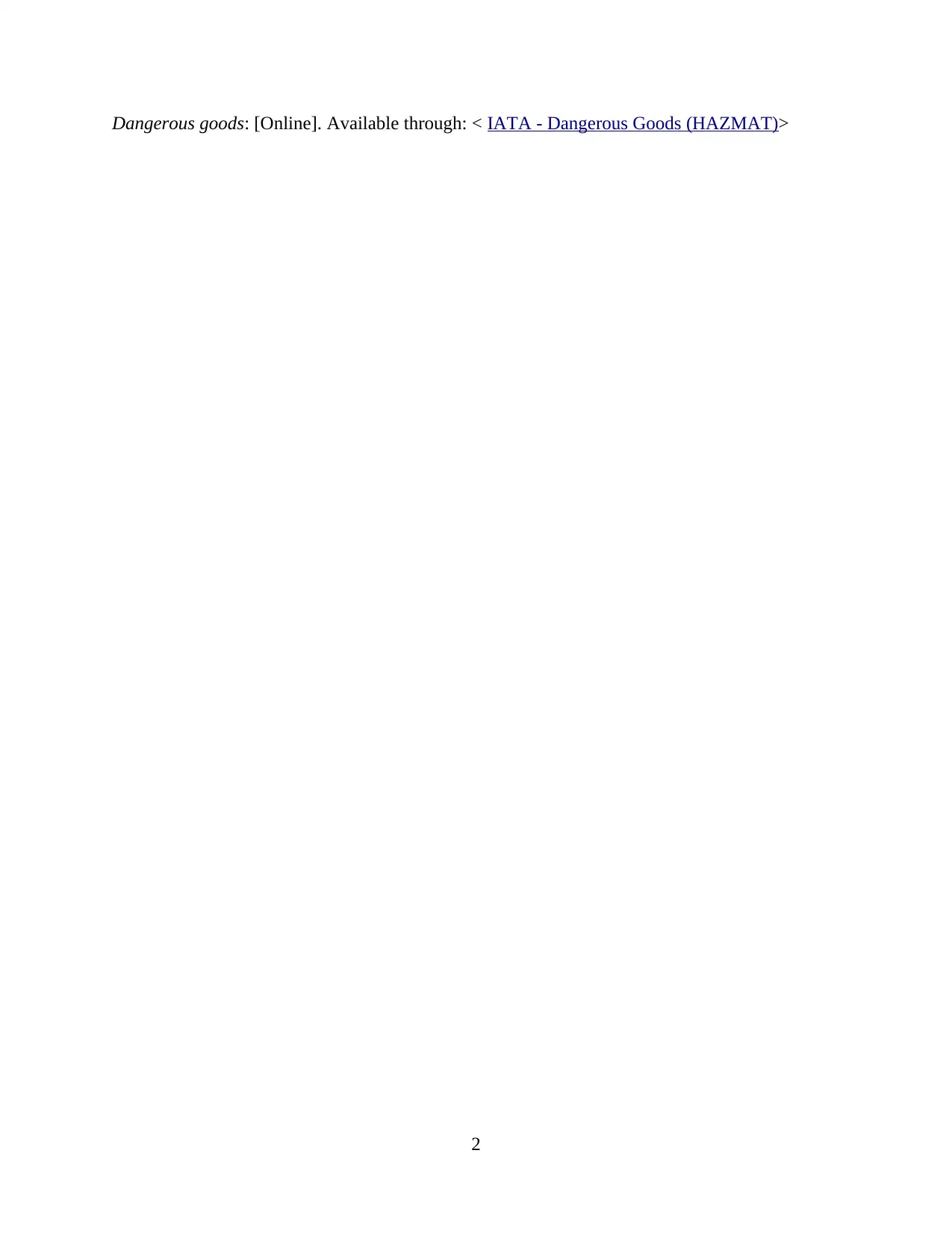
Dangerous goods: [Online]. Available through: < IATA - Dangerous Goods (HAZMAT)>
2
2
1 out of 11
Related Documents
Your All-in-One AI-Powered Toolkit for Academic Success.
+13062052269
info@desklib.com
Available 24*7 on WhatsApp / Email
![[object Object]](/_next/static/media/star-bottom.7253800d.svg)
Unlock your academic potential
Copyright © 2020–2025 A2Z Services. All Rights Reserved. Developed and managed by ZUCOL.





